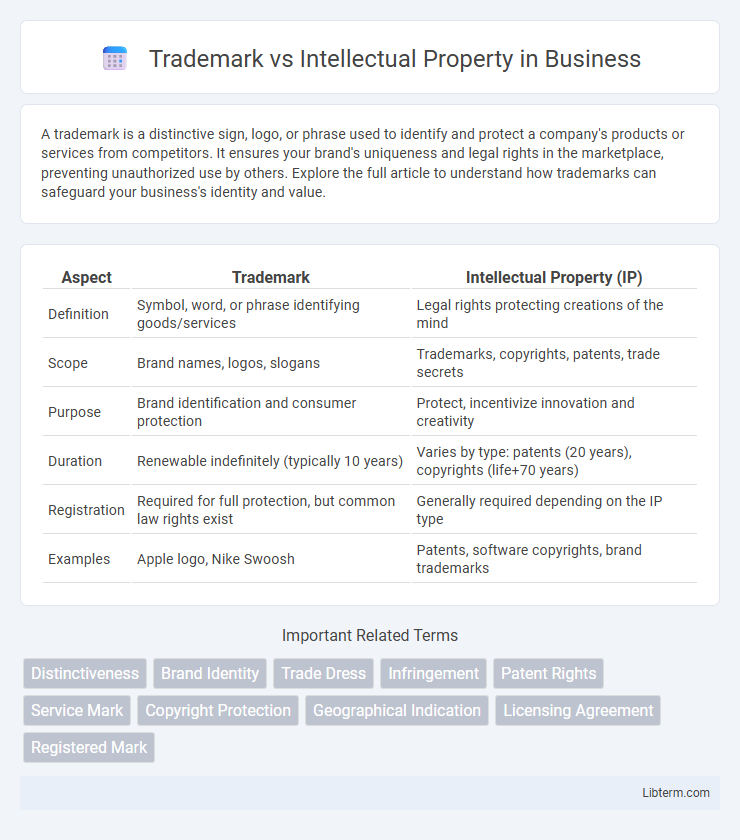A trademark is a distinctive sign, logo, or phrase used to identify and protect a company's products or services from competitors. It ensures your brand's uniqueness and legal rights in the marketplace, preventing unauthorized use by others. Explore the full article to understand how trademarks can safeguard your business's identity and value.
Table of Comparison
| Aspect | Trademark | Intellectual Property (IP) |
|---|---|---|
| Definition | Symbol, word, or phrase identifying goods/services | Legal rights protecting creations of the mind |
| Scope | Brand names, logos, slogans | Trademarks, copyrights, patents, trade secrets |
| Purpose | Brand identification and consumer protection | Protect, incentivize innovation and creativity |
| Duration | Renewable indefinitely (typically 10 years) | Varies by type: patents (20 years), copyrights (life+70 years) |
| Registration | Required for full protection, but common law rights exist | Generally required depending on the IP type |
| Examples | Apple logo, Nike Swoosh | Patents, software copyrights, brand trademarks |
Understanding Intellectual Property: A Broad Overview
Intellectual property (IP) encompasses a wide range of legal rights protecting creations of the mind, including patents, copyrights, trademarks, and trade secrets. Trademarks specifically protect brand identifiers such as logos, names, and slogans that distinguish goods or services in the marketplace. Understanding the distinctions within IP helps businesses strategically safeguard their innovations and maintain competitive advantages.
What Is a Trademark? Key Definitions
A trademark is a legally recognized sign, design, or expression that uniquely identifies products or services of a specific source, distinguishing them from others in the market. It serves as a symbol of brand identity and consumer trust, protecting against unauthorized use or infringement. Trademarks fall under the broader category of intellectual property, which includes patents, copyrights, and trade secrets, each safeguarding different types of creations and innovations.
Types of Intellectual Property: Where Trademarks Fit In
Intellectual property encompasses several distinct types, including trademarks, copyrights, patents, and trade secrets, each protecting different forms of creations and innovations. Trademarks specifically safeguard brand identifiers such as logos, slogans, and product names, ensuring consumer recognition and preventing confusion in the marketplace. By differentiating trademarks from other intellectual property types, businesses can strategically protect their brand identity while leveraging patents for inventions and copyrights for creative works.
Trademarks vs. Copyright: Core Differences
Trademarks protect brand identifiers such as logos, slogans, and names that distinguish goods or services in the marketplace, ensuring consumer recognition and preventing confusion. Copyright safeguards original works of authorship, including literary, musical, and artistic creations, granting exclusive rights to reproduce, distribute, and display these works. While trademarks focus on brand identity and market presence, copyright centers on creative expression and the protection of intellectual originality.
Trademarks vs. Patents: Distinct Protections
Trademarks protect brand identifiers such as logos, names, and slogans that distinguish goods or services, ensuring consumer recognition and preventing market confusion. Patents grant exclusive rights to inventors for new, useful, and non-obvious inventions or processes, enabling them to control the commercial use and production for a limited time, typically 20 years. Unlike patents, trademarks can be renewed indefinitely as long as they are in use, focusing on brand identity rather than invention protection.
Legal Protections Offered by Trademarks
Trademarks provide exclusive legal protections by allowing businesses to distinguish their goods or services through distinctive signs, logos, or names, preventing unauthorized use by competitors. Unlike broader intellectual property rights, trademarks specifically safeguard brand identity and consumer trust under laws such as the Lanham Act in the United States. Registration of a trademark grants the owner nationwide protection, the right to sue for infringement, and the ability to license or sell the mark, ensuring robust enforcement in the marketplace.
The Process of Registering a Trademark
Registering a trademark involves submitting an application to the relevant government authority, such as the United States Patent and Trademark Office (USPTO), which includes a detailed description and representation of the mark. The examination process entails a thorough review for conflicts with existing trademarks to ensure distinctiveness and compliance with statutory requirements. Upon approval, the trademark is published for opposition, followed by registration and periodic maintenance filings to retain exclusive rights under intellectual property law.
Intellectual Property Rights: Global Perspectives
Intellectual Property Rights (IPR) encompass trademarks, patents, copyrights, and trade secrets, providing creators and businesses legal protection against unauthorized use worldwide. Global perspectives on IPR emphasize harmonization through international treaties like the TRIPS Agreement under the World Trade Organization, ensuring consistent enforcement and protection standards across borders. Trademark rights specifically protect brand identity within the broader IPR framework, crucial for maintaining competitive advantage in global markets.
Common Misconceptions About Trademarks and IP
Trademarks are often misunderstood as encompassing all forms of intellectual property, but they specifically protect brand identifiers like logos and slogans, not inventions or creative works. Intellectual property includes patents, copyrights, trademarks, and trade secrets, each safeguarding different types of assets under the law. Confusing trademarks with broader IP rights can lead to ineffective protection strategies and missed opportunities for legal enforcement.
Choosing the Right Protection: Trademark or Other IP?
Choosing the right protection between a trademark and other forms of intellectual property depends on the nature of your asset: trademarks safeguard brand names, logos, and slogans that distinguish goods or services, while patents protect inventions, copyrights cover original works of authorship, and trade secrets guard confidential business information. Evaluating whether your creation primarily serves to identify the source of products or entails innovative technology or creative expression guides the decision. Consulting an intellectual property attorney ensures tailored protection strategies aligned with business goals and legal requirements.
Trademark Infographic

 libterm.com
libterm.com